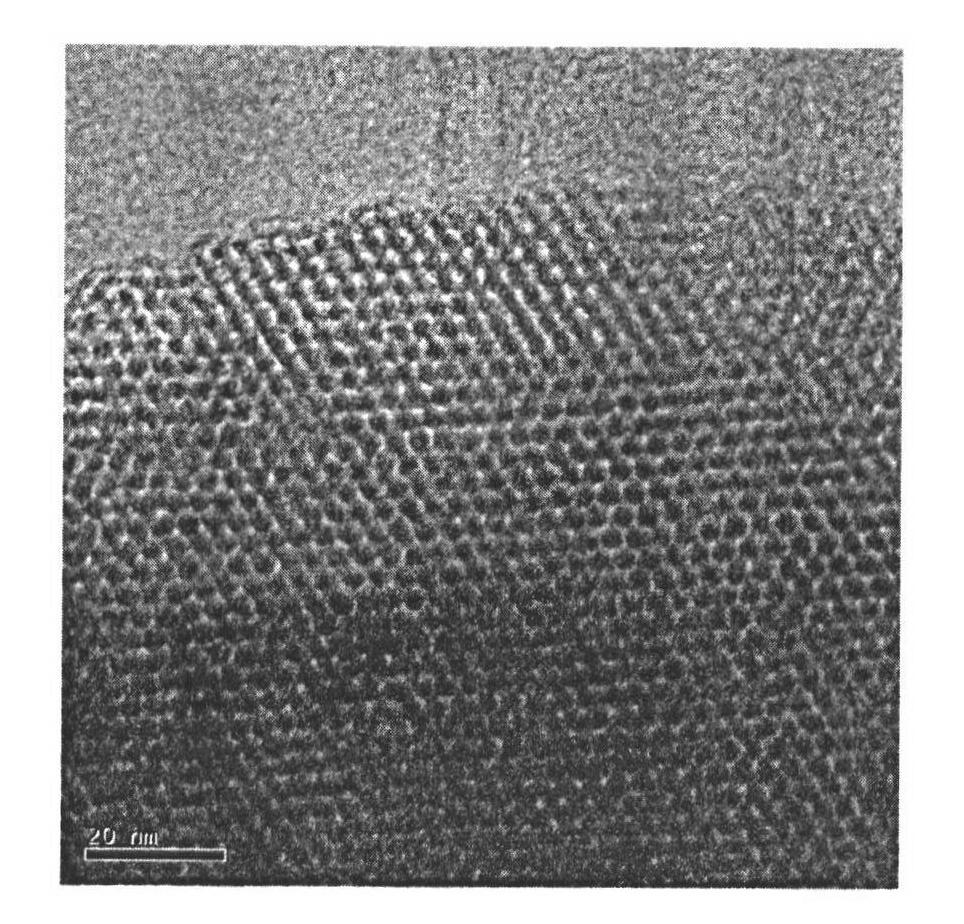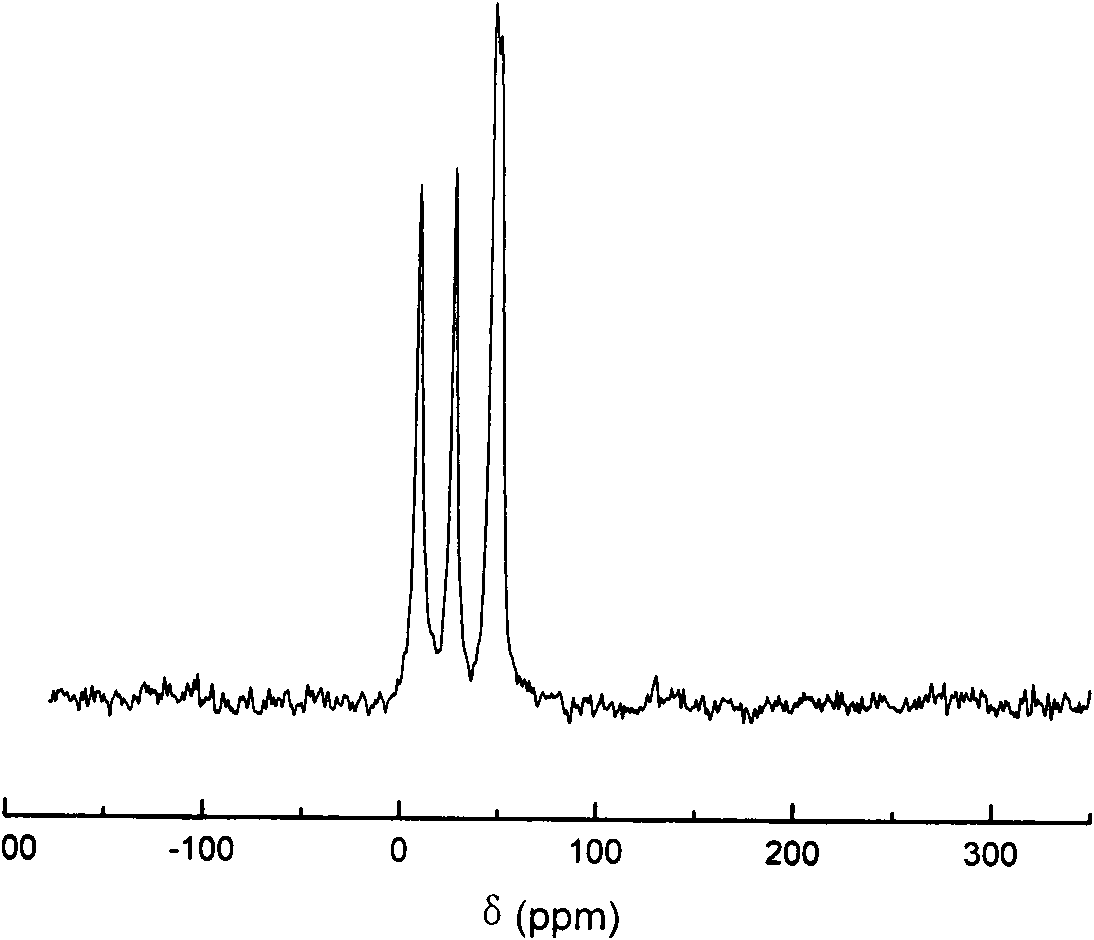Preparation of Ti-MCM-41 mesoporous material with functionalized ionic liquid and application thereof
A technology of ti-mcm-41 and mesoporous materials, applied in organic chemistry, chemical instruments and methods, chemical/physical processes, etc., can solve problems such as the difficulty of separating homogeneous catalysts from products and the limitations of homogeneous catalyst applications, and achieve The effect of simple preparation process and high catalytic activity
- Summary
- Abstract
- Description
- Claims
- Application Information
AI Technical Summary
Problems solved by technology
Method used
Image
Examples
Embodiment 1
[0024] Dissolve 5.46g of cetyltrimethylammonium bromide (CTAB) in 180mL of deionized water, add 12mL of ethylenediamine, stir well, (according to Si:Ti molar ratio is 50), add dropwise 20.8g of Ethyl silicate (TEOS), then add 0.68g butyl titanate and 40mL H 2 o 2 and 10mL of isopropanol, stirred for 2h, placed in a water bath at 80°C for 1h, then moved to a hydrothermal reaction kettle, hydrothermally treated at 100°C for 72h, and finally, filtered and washed with 300mL of deionized water, The obtained solid was dried at 100°C for 8 hours, then heated to 550°C at a rate of 1°C / min, and calcined at 550°C for 6 hours to remove the surfactant to obtain Ti-MCM-41(50).
[0025] Take 5.0 g of prepared Ti-MCM-41 (50), add 100 mL of toluene, add 5.0 mL of 3-chloropropyltrimethoxysilane, add 0.5 mL of triethylamine, and reflux at a temperature of 110 ° C for 48 h. After the end, cool to room temperature, carry out vacuum suction filtration, then successively wash with 100mL toluene, ...
Embodiment 2
[0028] Dissolve 6.10g of cetyltrimethylammonium bromide (CTAB) in 180mL of deionized water, add 12mL of ethylenediamine, stir well, add 23.2g of tetraethyl orthosilicate (TEOS) dropwise, and then add 1.85g butyl titanate and 100mLH 2 o 2 and 28mL of isopropanol, stirred for 2h, placed in a water bath at 80°C for 1h, then moved to a hydrothermal reaction kettle, hydrothermally treated at 100°C for 72h, and finally, filtered and washed with 300mL of deionized water, The obtained solid was dried at 100°C for 8h, heated to 550°C at a speed of 1°C / min, and calcined at 550°C for 6h to remove the surfactant to obtain Ti-MCM-41(70).
[0029] Take 5.0 g of prepared Ti-MCM-41 (70), add 100 mL of toluene, add 5.0 mL of 3-chloropropyltrimethoxysilane, add 0.5 mL of triethylamine, and reflux at a temperature of 110 ° C for 48 h. After the end, cool to room temperature, carry out vacuum suction filtration, then successively wash with 100mL toluene, 100mL ethanol and water mixed solution (1:...
Embodiment 3
[0032] The reaction of propylene oxide and carbon dioxide to generate propylene carbonate was carried out in a 50mL stainless steel autoclave and heated by electromagnetic stirring. In reactor, add 5g propylene oxide, add 0.4gTi-MCM-41-Im (50) catalyzer, then pass into carbon dioxide gas and evacuate, close outlet valve, after pressure shows 3MPa, close inlet valve. Stir and heat up to a reaction temperature of 130° C., and react at a constant temperature for 6 hours. After the reaction, the reaction kettle was placed in an ice-water bath for 3 hours, and then unreacted carbon dioxide gas was released, and the solid catalyst was separated by centrifugation to obtain the product.
[0033] The product is analyzed by gas chromatography: hydrogen flame ionization detector, nitrogen as carrier gas, gasification chamber temperature 260 °C, detector temperature 260 °C, sample volume 0.2 μL, analysis conditions are initial column temperature 40 °C, and then The temperature was raised...
PUM
 Login to View More
Login to View More Abstract
Description
Claims
Application Information
 Login to View More
Login to View More - R&D
- Intellectual Property
- Life Sciences
- Materials
- Tech Scout
- Unparalleled Data Quality
- Higher Quality Content
- 60% Fewer Hallucinations
Browse by: Latest US Patents, China's latest patents, Technical Efficacy Thesaurus, Application Domain, Technology Topic, Popular Technical Reports.
© 2025 PatSnap. All rights reserved.Legal|Privacy policy|Modern Slavery Act Transparency Statement|Sitemap|About US| Contact US: help@patsnap.com



